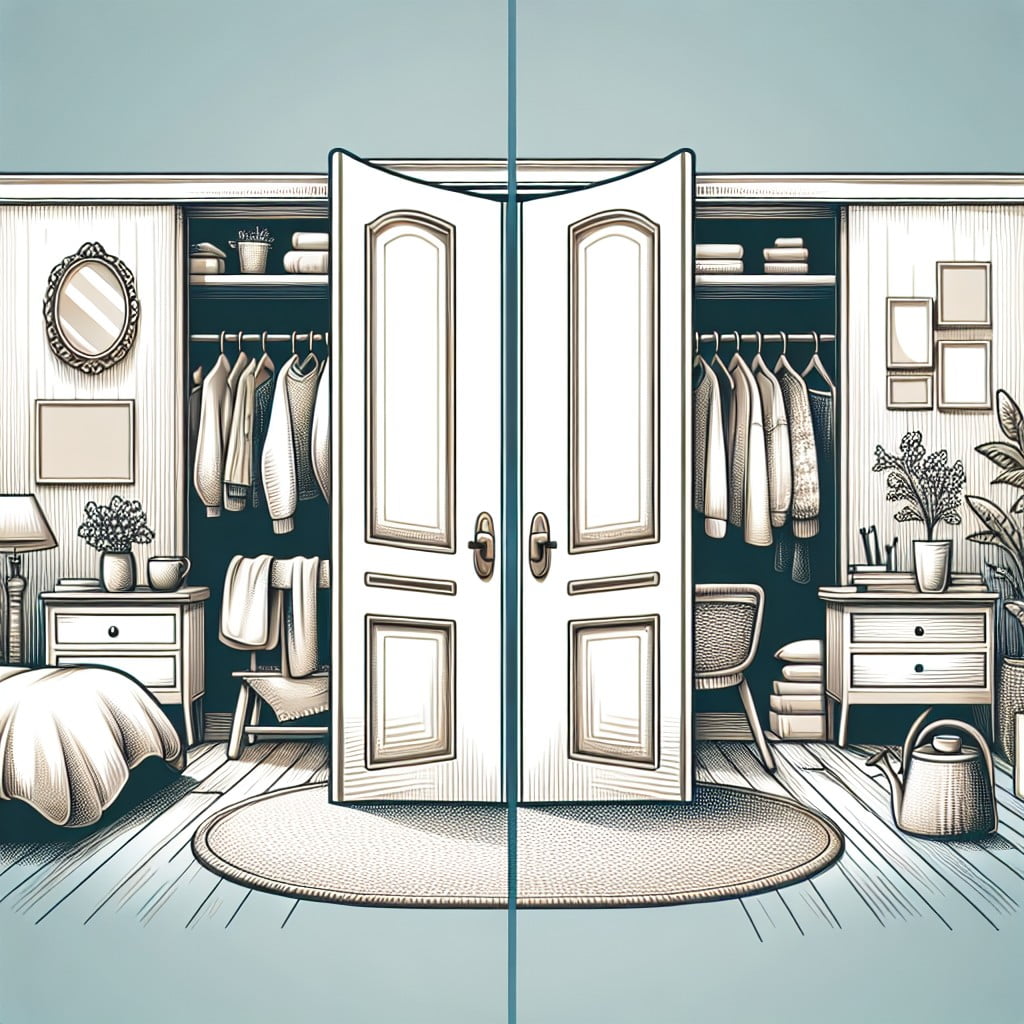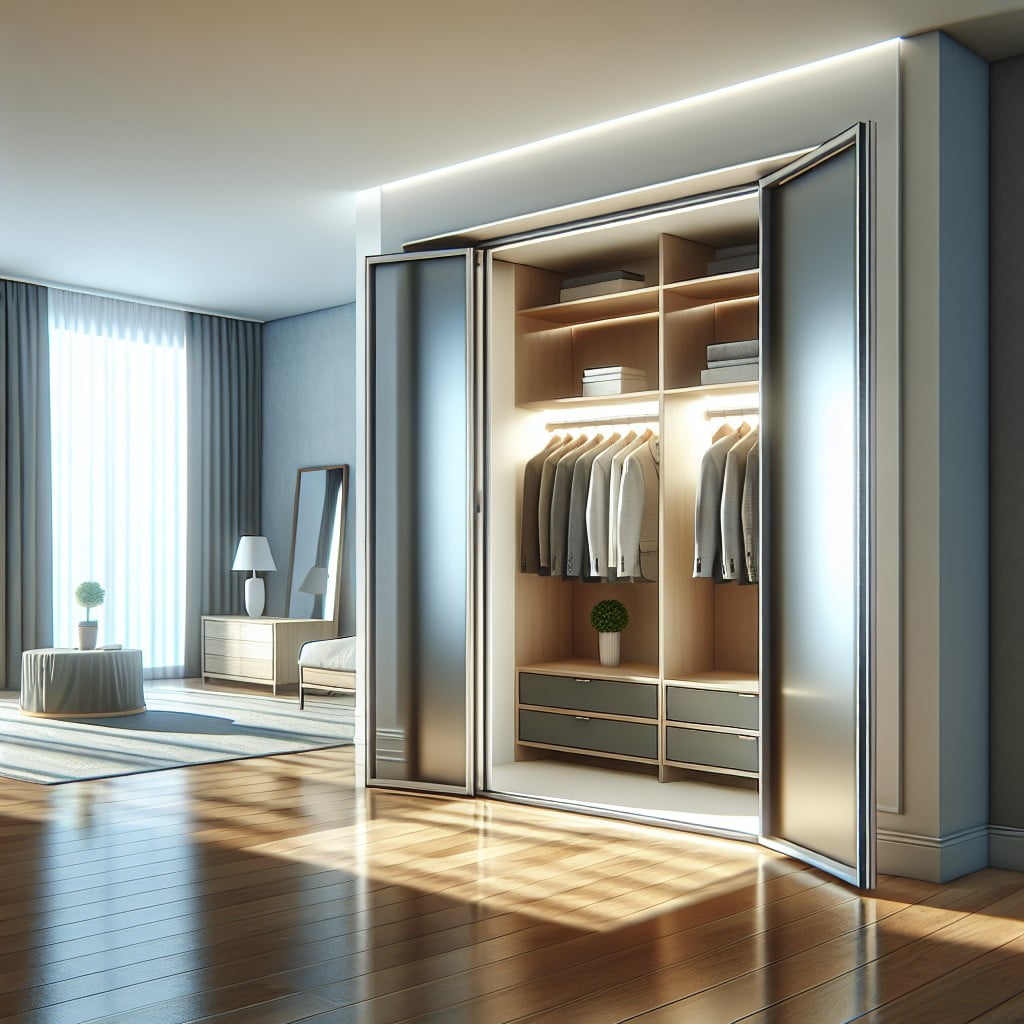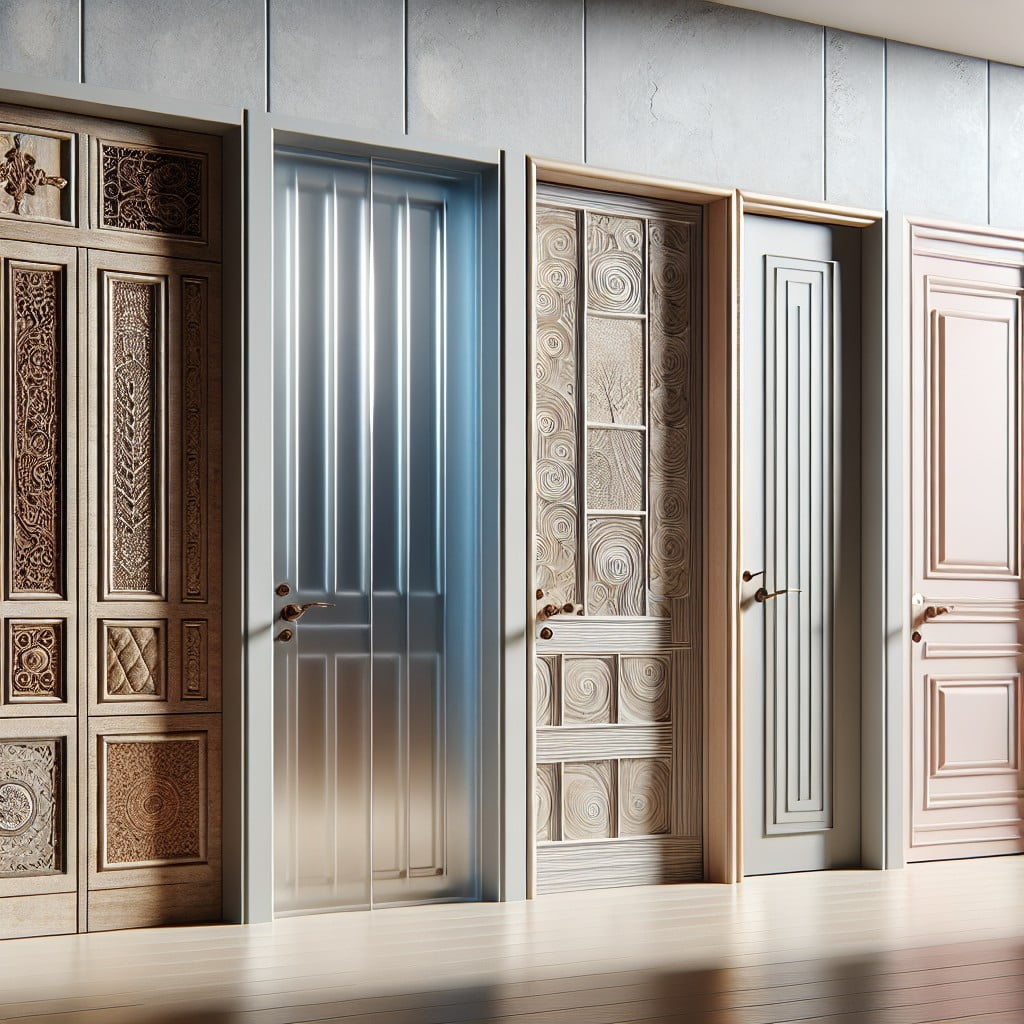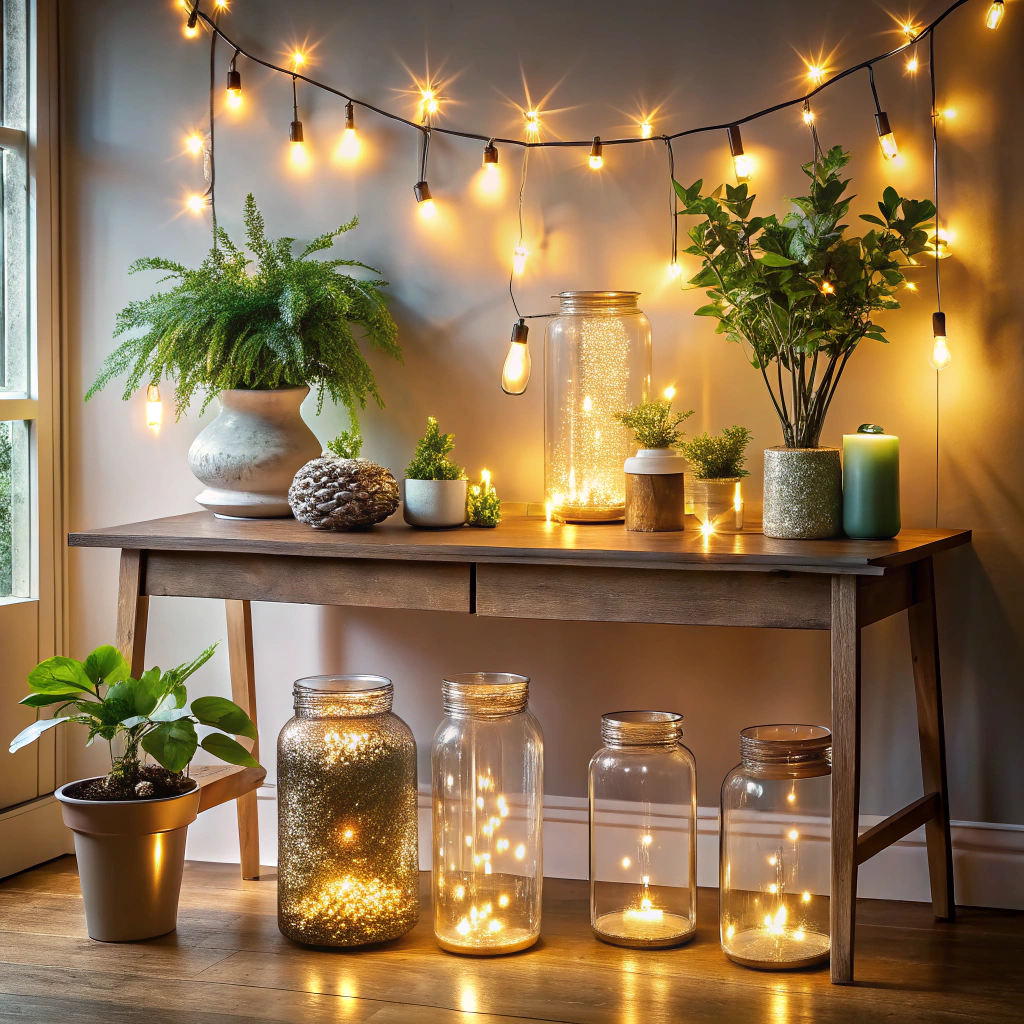Last updated on
Because variety is indispensable in choosing the right closet door, this comprehensive guide unveils an array of distinct types to compliment your unique style and space requirements.
Key takeaways:
- Hinged Swing Doors: Versatile and practical, easy to install.
- Bifold Doors: Ideal for small spaces, customizable with various materials.
- Sliding Doors: Seamless design, perfect for wide closets.
- Materials Used: Wood, MDF, Metal, Glass, PVC/Vinyl, Mirror.
- Panel Styles: Flat, Raised, Louvered, Glass, Combination.
Hinged Swing Doors: The Traditional Choice

Commonly found in many homes, these doors swing open from a single side, typically requiring more space to operate than other types. They are mounted on hinges and can be designed as a single door for small closets or double doors for wider spaces, offering full access to the closet contents.
Versatility is a key trait, as they can come in various materials like wood, metal, or glass, and finishes to match any room’s decor. Due to their standard design, they are often easier to install and maintain, making them a practical solution for those seeking functionality without complication.
Adding mirrors or intricate detailing can elevate their appearance, creating both a functional space and an aesthetic statement.
Bifold Doors: The Space Savers

Ideal for smaller spaces, bifold doors fold in on themselves, making them a practical option for closets in tight areas. Unlike hinged doors that require clearance to swing outward or inward, these doors neatly collapse and tuck away, allowing you to maximize the use of the available space. Such a design not only provides full access to the closet’s contents but also minimizes the intrusion into the room, making it easier to arrange furniture and navigate.
They typically consist of two or more panels connected by hinges. When opened, the doors fold along the hinge lines and slide on a track set at the top or bottom of the door frame, which guides their movement. As a bonus, the reduced swing space needed for bifold doors often makes them a preferred choice for walk-in closets or smaller bedrooms.
While they can be slightly more complex to install due to the track and folding mechanisms, bifold doors are relatively user-friendly once in place. Their versatility is also worth noting – with a wide range of materials and finishes available, from classic wood to mirrored panels, there’s a style to complement any room decor. Additionally, for those who enjoy DIY projects, bifold doors can be customized with paint or hardware to add a personal touch to the closet design.
Sliding Doors: Seamless and Stylish

Sliding closet doors offer an appealing aesthetic that melds functionality with modern design. They are ideal for smaller rooms where saving space is a priority, as they don’t require the clearance that hinged doors do. This type of door glides along a track system which can be installed on the top, bottom, or both for added stability.
Made from a variety of materials, including wood, glass, or mirrored panels, sliding doors can suit a range of tastes and decors. When open, they offer unobstructed access to half of the closet at a time, making them a practical choice for wide closets. Moreover, their sleek operation and the ability to conceal the hardware provide a clean, uncluttered look.
For those seeking a contemporary twist, frosted or etched glass options also exist, allowing light to filter through while maintaining privacy. Keeping the tracks clean ensures smooth operation and longevity, adding to the low-maintenance appeal of sliding doors in any home.
The Materials Used in Closet Doors

Choosing the appropriate material is crucial for both the functionality and aesthetic of closet doors. Here’s a quick guide to the most common materials:
1. Wood: A popular choice for its natural beauty, it can be stained or painted to match any decor. Solid wood doors are durable but might be pricier and heavier.
2. MDF (Medium Density Fiberboard): Offering a smoother finish than wood, MDF is great for painting. It’s also more affordable and resistant to warping.
3. Metal: Typically used for sliding or bifold doors, metal options offer a modern look and are less susceptible to damage.
4. Glass: Often combined with other materials, glass panels can make a space feel larger and brighter. Frosted or textured options provide privacy while still allowing light through.
5. PVC or Vinyl: Lightweight and moisture-resistant, these materials are ideal for budget-friendly installations and are easy to clean.
6. Mirror: These doors serve a dual purpose by providing a full-length reflection and the illusion of a larger room.
Remember that the material influences not just the appearance, but also the door’s weight, feel, and the hardware required for installation.
Panel Styles of Closet Doors
Panel doors are defined by the number of panels, their shape, and arrangement, offering aesthetic diversity for interior design. Flat panel doors present a clean, minimalistic look, perfect for modern decor. Raised panel doors, with elevated center sections, add dimension and traditional elegance to a room. Louvered panels, comprised of angled slats, provide ventilation for closets, making them ideal for laundry spaces or areas where airflow is desired. Glass paneled doors can incorporate frosted or clear glass to add a sense of openness while disguising closet contents. Finally, the combination-panel doors mix different styles, allowing for creative expression and a unique closet facade.
Each panel style contributes to the door’s overall function and complements various design schemes.
Customization Options for Closet Doors
Tailoring your closet doors to fit the aesthetic and functional needs of your space can transform a room. Consider these options when customizing:
1. Glass Inserts: Choose frosted glass for a sleek look that adds light while obscuring contents, or clear glass to showcase organized interiors.
2. Mirror Panels: Adding mirrors can make a room appear larger and brighter while providing a full-length reflection.
3. Louvered Slats: Allow air circulation in musty closets and add a distinctive design element with angled slats.
4. Raised or Flat Panels: Raised panels add dimension and traditional elegance, while flat panels offer a clean, modern appearance.
5. Hardware Finish: Select from brass, nickel, chrome, or matte finishes to complement your room’s hardware and fixtures.
6. Soft-Close Mechanisms: To prevent slamming, soft-close features can be integrated, ensuring a quieter and safer operation.
Each of these options not only enhances the look of closet doors but also contributes to the room’s overall functionality and ambiance.
Maintenance Insights for Various Closet Door Types
Proper upkeep ensures longevity and smooth operation for all closet door types. For hinged swing doors, periodically tightening the hinges and lubricating them can prevent annoying squeaks and ensure they open with ease. Checking alignment is also key—a slight adjustment can make a significant difference in functionality.
Bifold door tracks attract dust and debris, which can hamper their movement. Regular cleaning of the tracks, combined with a bit of lubrication, can keep them gliding smoothly. Ensure that the pivot points and brackets are secure and correctly adjusted to avoid any dragging or misalignment issues.
Sliding doors operate with rollers on a track, so it’s essential to clear these tracks of obstructions and use a silicone-based lubricant for uninterrupted movement. Worn-out rollers can often be adjusted or replaced, which is a simple yet effective way to maintain usability.
The material of the door also dictates maintenance. Wood doors may require touch-ups with paint or stain over time, especially if exposed to direct sunlight, to prevent warping and discoloration. Meanwhile, mirror-finished or glass doors benefit from regular cleaning with appropriate glass cleaners to keep them looking pristine and streak-free.
Remember, gentle handling of all doors can go a long way in preserving their function and appearance—forceful movements can knock doors off their tracks and create the need for more frequent repairs.
Selecting the Right Color Scheme for Closet Doors
Matching the room’s color palette ensures a cohesive look. Consider if you want the doors to blend in or stand out; neutral tones work well for blending, while bold hues make a statement.
For a streamlined appearance, match the door color to your trim or molding. Light colors can make a small room feel larger, while dark colors add sophistication and can highlight a spacious closet.
Think about the finish as well; glossy paints reflect light and add brightness, whereas matte finishes offer a more subdued look. Remember that paint isn’t your only option; wood stains, frosted or mirrored glass, and even fabric inserts can add texture and interest to your closet doors.
Always test colors in your actual space, as lighting dramatically influences how colors appear.
FAQ
What is the best type of door for a closet?
The best type of door for a closet is a hinged swing door due to its simplicity, ease of installation, and cost-effectiveness.
Are sliding or bifold closet doors better?
Bifold closet doors are considered advantageous over sliding doors as they provide easier and full access to the space, with the added flexibility of opening just one panel when needed.
What is the new trend instead of bifold doors?
The new trend replacing bifold doors is pivot doors, known for their stylish, contemporary look and their ability to open on an axis rather than sliding.
What is the difference between bypass closet doors and bifold closet doors?
Bypass closet doors slide open while bifold closet doors fold open, and although bypass doors offer a more contemporary look, both door types can be customized to fit a homeowner’s or business’s unique taste.
What are some cost-effective alternatives to traditional closet doors?
Some cost-effective alternatives to traditional closet doors include curtains, folding screens, sliding barn doors, and freestanding wardrobes.
How can mirrored closet doors enhance a room’s aesthetic?
Mirrored closet doors can enhance a room’s aesthetic by creating a spacious illusion, reflecting natural light, and adding a touch of modern elegance.
What maintenance needs should one consider for different types of closet doors?
The maintenance needs for closet doors will vary depending on the type, with sliding or folding doors requiring regular cleaning and checking of tracks and rollers, mirrored doors needing careful cleaning to avoid scratches, and wooden doors requiring occasional refinishing to prevent wear and warping.
Recap:




